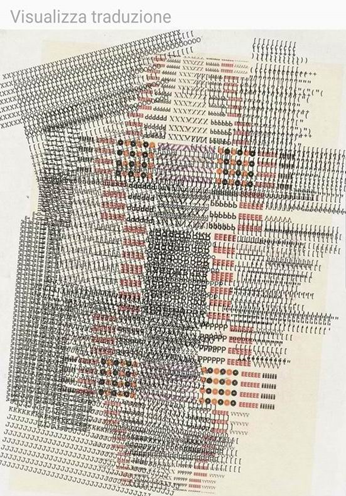Special Feature: Beyond the Wall - A Visual Writing Exhibit
“The Wizard of Nothingness”

De Villo Sloan’s favorite poetic style is concrete. Concrete poetry dates to the 1600s and earlier—the “metaphysical poets.” Concrete poetry suggests the idea that language, symbolized as letters inside literal forms, constitutes materiality. But Sloan has invented a new style of concrete writing—“asemic concrete,” “neo-concrete,” possibly, global concrete. Similar to earlier concrete poems, Sloan’s neo-concrete artworks consist of letters—basically printed letters—presented in an assortment and arrangement of forms—but, rather than literal forms, indeterminate, endless, multiple and abstract forms. The letters themselves often appear as abstract shapes and patterns also. Rather than symbolizing “concrete,” Sloan’s new artworks (as visual poetry and visual writing) symbolize just the opposite—translucence, transparency, conceptuality, invisibility. Early concrete poetry makes nothing (language) into something (“concrescence,” materiality). Neo-concrete poetry (along with visual writing) makes something (materiality, structure) into nothing (the tenuous substance and invisible meaning of language).

De Villo Sloan’s favorite poetic style is concrete. Concrete poetry dates to the 1600s and earlier—the “metaphysical poets.” Concrete poetry suggests the idea that language, symbolized as letters inside literal forms, constitutes materiality. But Sloan has invented a new style of concrete writing—“asemic concrete,” “neo-concrete,” possibly, global concrete. Similar to earlier concrete poems, Sloan’s neo-concrete artworks consist of letters—basically printed letters—presented in an assortment and arrangement of forms—but, rather than literal forms, indeterminate, endless, multiple and abstract forms. The letters themselves often appear as abstract shapes and patterns also. Rather than symbolizing “concrete,” Sloan’s new artworks (as visual poetry and visual writing) symbolize just the opposite—translucence, transparency, conceptuality, invisibility. Early concrete poetry makes nothing (language) into something (“concrescence,” materiality). Neo-concrete poetry (along with visual writing) makes something (materiality, structure) into nothing (the tenuous substance and invisible meaning of language).
